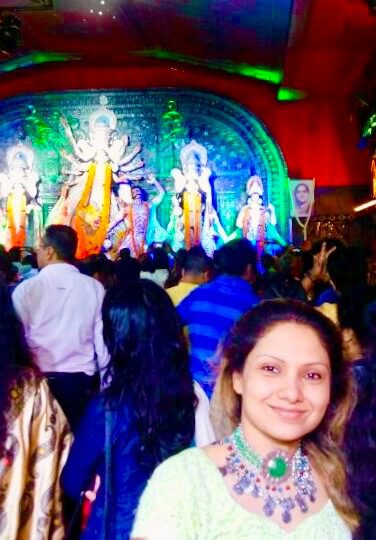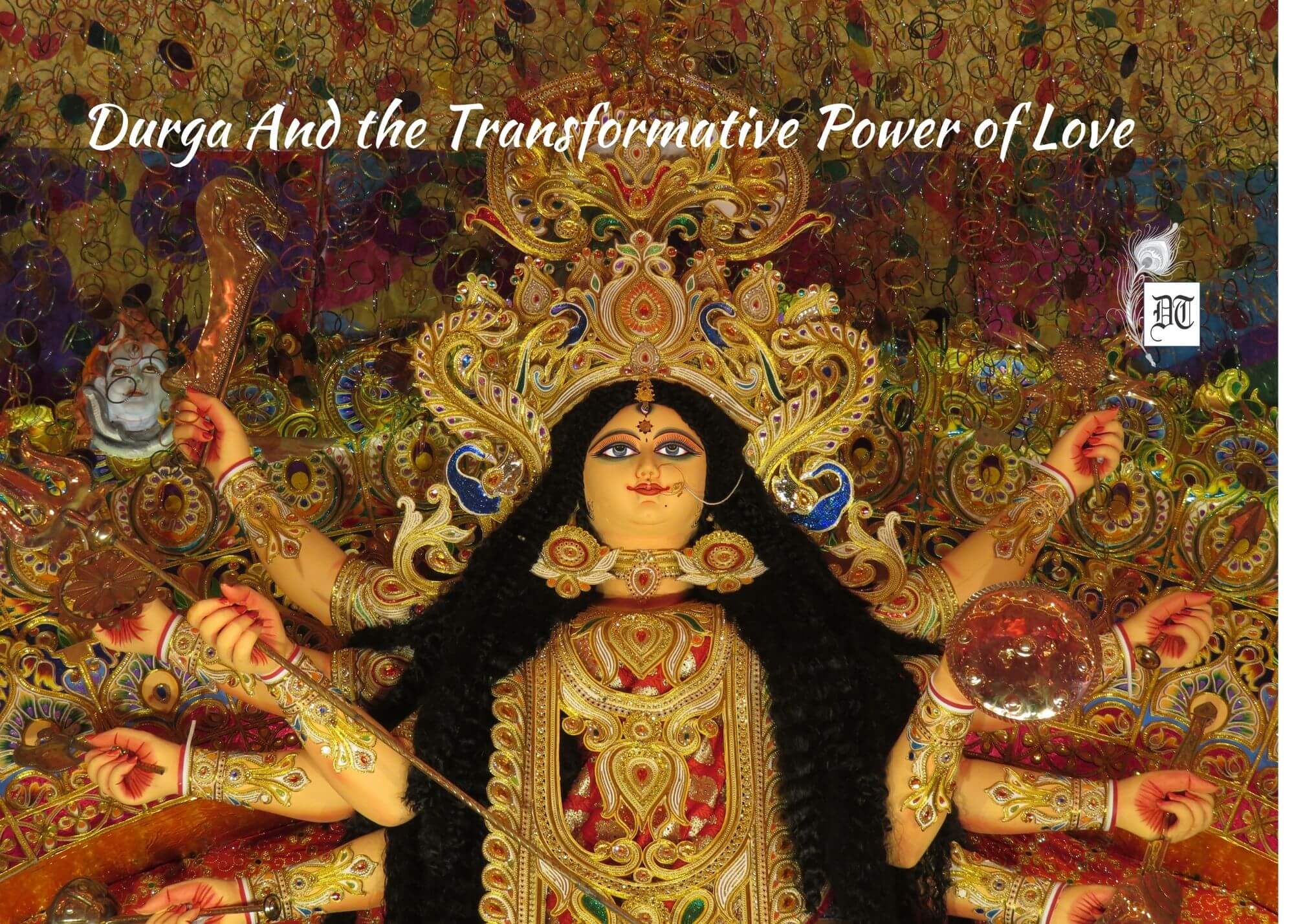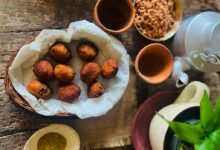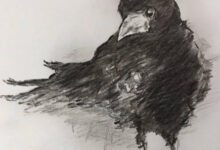In a personal essay, Urna tells us what Maha Ashtami means to her. It honours Durga, a goddess of strength and resilience, encouraging worship of the “durg” within our hearts as a cosmic mother, exclusively for Different Truths.
It’s that time of the year again when the crisp autumn air crackles and kindles with boundless energy, shimmering to the persistent beats of the “dhakis” at their “dhaks”. The “dhak” is the large membranophone drum that a “dhaki” or drummer hangs around his neck and plays with two thin sticks. The enchanting beats announce that there is quintessential poetry in the air, especially for those who believe in the sweet pirouettes of the gifts that seasonality brings to us.
This weekend is Maha Ashtami (Oct 22). I stand amidst the lavish Sarbojanin (Sarbo is all and Jana/Janin means people or the common man’s pujo. It started in Baghbajar, North Kolkata, in 1910, by Atindranath Bose, irrespective of caste and creed) pandal decorations and can’t help but think how Brahma, Vishnu, and Shiva combined all the might in their respective arsenals to construct a formidable female form with ten indomitable arms. The Goddess Durga was created to fight Mahishasura, a demon who with his sharp, cunning acumen and manipulative muscle had become the ruler of all the three realms, unleashing a veritable reign of terror.
The beats of the “dhak” at the pandal around me rise at a steady, rhythmic pace, its cadence performing a primal dance…

The beats of the “dhak” at the pandal around me rise at a steady, rhythmic pace, its cadence performing a primal dance on my otherwise calm pulse, transmuting it with rambunctious joy. Yet, I stand still before the Goddess, my feet rooted to the ground beneath me, and look into her eyes as she towers ahead of me, far beyond me – magnificent, resplendent, all-encompassing like the cosmos. And I think how all the celestial powers came together to give Durga a bodily form when she arose as a spirit from the sacred waters of the Ganga. Shiva sculpted her face, while Indra sculpted her torso. Chandra created her breasts, while Brahma created her teeth. Bhudevi moulded her lower torso, Varuna moulded her thighs and knees, and Agni chiselled Durga’s eyes.
I keep staring at her eyes as if I’m in the grip of an unshakeable trance. The Goddess Durga looks back at me, I feel, igniting in my bones the same fire that her eyes were chiselled from. “Ma Durga” as we Bengalis call her, is the ultimate force born from the mystical amalgamation of the collective power of all the other gods. Durga, also known as “Mahamaya”, is the Great Mother of the Cosmos.
Durga ultimately slayed the demon king with her trident after a prolonged, arduous battle as the three realms quaked with fear and uncertainty till the momentous hour of her victory, and then, peace was once again restored.
As the all-too-familiar story of the Goddess Durga courses through my throbbing veins…
As the all-too-familiar story of the Goddess Durga courses through my throbbing veins, I reflect upon how “Durga” and “Shakti” are perfectly aligned, synonyms and are easily interchangeable from the cultural moorings that I and many like me hail from.
Meanwhile, the aromatic, slightly sticky autumn air redolent with drum beats swirls around me in an inebriated embrace, and I think about how Durga is etymologically rooted in the Sanskrit words, “du” meaning “difficult” and “ga” meaning “crossover”. Therefore, the word “durg” means a “fort” or a “fortress” that is difficult to cross over. And, “Durgatinashini,” which means “the one who eliminates suffering,” is another name for Durga too.
This leads me to understand the iconography of Durga in a way that I have never been able to grasp before. And, I feel a subterranean compulsion to dive deep into why Durga means so much to us as an icon, a visual symbol, a motif, a cultural construct, or a primordial force to reckon with. Invoked, revered, worshipped, and honoured for what we commonly refer to as her unassailable “shakti”.
Shakti as I understand the word means “power,” a kind of life force, an indefatigable source of energy.
Shakti as I understand the word means “power,” a kind of life force, an indefatigable source of energy. Something that we all need to draw upon to ride the unpredictable highs and the treacherous lows of our fragile human lives.
Now, to do a deep dive to evaluate and assess what “shakti” truly means in all honestly to me, I reckon I must begin by getting into flashback mode somewhat. And so as if nudged by Ma Durga’s large, kohl-lined, expressive almondeyes I decided to saunter down the serenading alleyways of my memory.
Many moons ago, as a restless, young child, my perceptions, ideas, and notions of “shakti” or “power” were pretty clear and well-defined. He-Man’s sword for me was all about the “power” of courage. As He-Man or Prince Adam of Eternia, brandished his sword, showing us his rippling muscles, and hollered in his deeply magnetic baritone, “By the power of Greyskull…” from our drawing room television set, I was utterly convinced.
When Popeye, the pugnacious, wisecracking sailor, pulled out his always-handy can of spinach from his shirt, it was clear to my childlike mind that his superhuman strength stemmed from the “shakti” of spinach. And that I too must eat my spinach, without whining. Or else, I could run the risk of being weak and powerless. Only when I was much older that I stumbled upon a fun statistic that revealed Popeye had helped increase American consumption of spinach by a third. Whoa! Now, that’s food for thought, right?
Then again, remember the ugly toad who turned into the dapper prince when kissed by the princess? That to my young mind full of dreams was a fairly convincing metaphor about the transformative “shakti” of love.
Speaking of love, oh how I obsessed over my love for Wham and George Michael.
Speaking of love, oh how I obsessed over my love for Wham and George Michael. As their songs climbed the international music charts quicker than my heartbeat, it became amply clear to my young, formative mind how tremendously far-reaching the “shakti” of music can be.
Cut to a few years later. The inveterate geek that I was, I poured over books, when most girls my age discussed cute, good-looking boys. And with many summer afternoons spent between the thick, hard-bound covers of classics, I grasped and understood how knowledge truly equals “shakti” and will always be so.
Later, when I became a Vice Captain in senior school, nominated at first by a council of sombre-looking, bespectacled teachers and then voted by my bubbly and vivacious schoolmates, I understood a thing or two about the “shakti” of leadership. And how leadership is the twin sister of responsibility and that the twain go hand tightly clasped in hand.
In other words, “shakti” was something that was always and perennially external to me. Outside of my entity, beyond the jaws of my control. But mind you, it could be given to me, or granted to me, or gifted to me, by someone or something that was again…outside of me.
That was more or less how I perceived the notion or idea of “shakti”.
That was more or less how I perceived the notion or idea of “Shakti”. And I was quite happy with my notional constructs – they seemed to make perfect sense too as I knocked on the doors of adulthood, waiting with bated breath to “drink life to the lees”.
However, as the years rolled by and I started my career as a young copywriter, working long hours with a much sought-after, internationally renowned advertising giant in Mumbai, something in me started shifting. It happened almost at a snail’s pace, at first. But it happened nevertheless. Grain by grain. Drop after drop. Whiff upon whiff.
Slowly but surely, some of the borrowed or perhaps my notions which were jumbled together to somehow form a perfect, cohesive whole earlier, suddenly seemed to grow too many gaping holes. In hindsight, maybe that’s what experience or growing older does to us all. Revealing to us the glaring chinks in the armour that looked pretty much invincible, just a few years back.
And it seemed to me as I worked hard, day and night, that this indefinable “shakti” would be hollow and meaningless, insular, and restrictive if it were only to be drawn upon or borrowed or taken or received from sources outside of oneself.
What about me? Was I powerless? Is the individual always at the receiving end?
What about me? Was I powerless? Is the individual always at the receiving end? Where does one go to refill one’s power when one runs dry? Is there a secret source or a fountain? Well, the seasons rolled by as they always do, and many of my earlier notions somehow started to seem dated, silly, and wishy-washy.
Then one rain-drenched July evening, as I looked out at the Arabian Sea from Marine Drive and stared at its endless expanse, feeling ever so small and diminutive, almost ironically, I understood where “shakti” truly comes from.
“Right from within each of us,” nudged a small voice from inside of me. Yes, from a vast expansive ocean of consciousness that’s right inside of us, I thought to myself as I watched the Arabian Sea crashing with all its might upon the rock-laden promenade of Marine Drive. Yes, “shakti” comes from the swelling, cresting, replenishing churn of our thoughts, I reflected. From our nourishing depths. From our tidal waves – our very own waning and waxing. And from our ability to always find the shore, no matter how tumultuous the waters may get or how exhaustive the battles may turn.
Does that mean that all my earlier notions were flawed? Well, perhaps not. Some were and some weren’t. However, some notions needed to be reevaluated, revised, remixed, and rehashed. For “shakti” can be both, external and internal. We can draw inspiration, courage or strength from the outer landscape, or our inner landscape. From external stimuli, or our internal stimuli.
But to think that Shakti is “only” and “exclusively” external in nature is tantamount to not taking responsibility for who we are…
But to think that Shakti is “only” and “exclusively” external in nature is tantamount to not taking responsibility for who we are and what we are here to do. It’s disempowering our magical human lives. Demeaning and diminishing all that we are capable of. Devaluing our creativity, inventiveness, potential and our extraordinary human gene that has evolved through millennia of survival.
Hand on my heart, adulting is hard and I won’t mince my words as life is an unpredictable game of snakes and ladders. But look, if hardships, trials, and tribulations have taught me one thing, it’s this: I can always come back to the “durg” – this fortified, brick-laden fortress, surrounded by the Arabian Sea, right within me.
Suddenly I snap away from my reverie and come back to the present. Someone shouts from afar, “Come closer Urna, the arati is about to begin”. I look up at Ma Durga’s eyes again. I remind myself to return to myself, every time.
Real, infinite “Shakti” is right there inside of me, inside of you, inside of each one of us.
Real, infinite “Shakti” is right there inside of me, inside of you, inside of each one of us. You are your drifting, foaming, gushing, heaving, life-giving Arabian Sea. You are also your own “durg”, fort, fortress, fortification, tower, lighthouse, citadel, or palace.
As the evening arati commences the holy chants impregnate the air with an aura of unspoken invincibility, that only the dazzle of the thousand oil diyas can mystically confirm and affirm. I look around me, everyone in the pandal is intently staring into Ma Durga’s eyes as if we are all in a collective trance.
This Saturday is Maha Ashtami. Every single day can become Maha Ashtami. If only we choose to worship the “durg” within our hearts that the ten-handed Ma Durga prods us to invoke and then gently leads and guides us, as a Cosmic Mother would, to seek and find, with the fiery benediction of her large, kohl-lined, expressive almond eyes.
Picture design by Anumita Roy and a photo by the author.






 By
By
 By
By

An excellent write up. Congratulations.